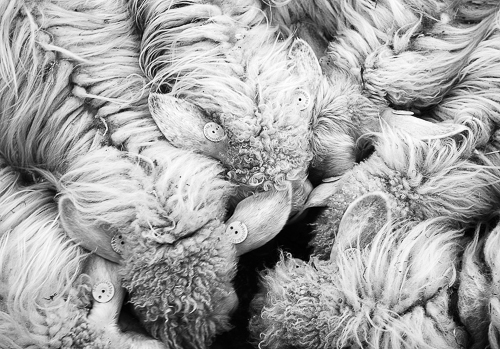After having been driving in the countryside east of Osilo for some kilometres, we arrived at the Turra farm situated at the top of a small hill. From there, we were able to see rolling hills and valleys besides a set of windmills in the horizon. Briefly, it’s a very beautiful and sparsely populated area.
The Turra farm is managed by Giovanni Turra, his son Gavinuccio and his wife Rina, and has been family-driven for many generations.
The Turra farm, a Slow Food presidium, is producing sheep’s cheese according to ancient traditions. Having lots of hills and valleys at their disposal, the 350 Sarda sheep at the farm can roam freely across a large area, making superb mutton.
Since it was time for milking shortly after we had arrived, we could watch a group of sheep together with a flock of lambs coming from a nearby meadow and entering the house where the milking should take place. Gavinuccio first put feed in a long trough, then the sheep were allowed to enter a long row of vertical bars, putting their heads between the vertical bars and eating from the trough. After having locked the heads of all the sheep by closing the bars around the head of each sheep, we could watch Gavinuccio doing the milking manually. Thereafter, we were invited into the dairy, where Giovanni and Rina had finished making their famous sheep’s cheese and ricotta just before we arrived.
While Gavinuccio was milking the sheep, we were shown around the dairy by Rina and her father-in-law Giovanni. The dairy has about 20 presses in addition to appropriate weights which are used to compress the cheeses and the ricotta mustia (a soft, delicate, white and compact cheese) in order to press out the whey, that is the liquid part of the milk. After having been compressed for some hours, the sheep’s cheeses are transferred to containers filled with water and salt. The cheeses stay floating in this mixture for some days. At the same time, as much salt is added that it isn’t dissolved in the water. Besides, a layer of salt is added on top of each cheese because the salt aids in getting rid of the whey. After the salting, the cheeses are stored in a cellar with a stable temperature around 15°C in order to mature.
Rina and her father-in-law also produce ricotta dolce and ricotta mustia, the latter being smoked in a small room by means of burning aromatic branches of Mediterranean maquis (mastic, wild olive, juniper, etc.). Before the smoking is carried out, the elliptical discs of ricotta, previously salted and compressed, are placed on a bed of reeds, collected from groves of reeds which grow abundantly along river banks nearby.
Of course, we couldn’t leave the farm without having accepted a coffee gently offered by Rina.

